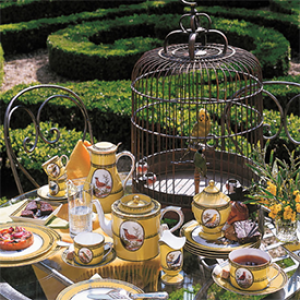
 Online Shop You don't have products
Online Shop You don't have products in your cart

The History of Porcelain
In the XIII century, while traveling around China, Marco Polo discovered a beautiful ceramic, unknown in the West. This clay was:
As white as jade.
As thin as paper.
As shiny as crystal.
This beautiful ceramic was the result of years of research and tremendous physical labor. Chinese people guarded jealously the secret of the manufacturing process. The kaolin was taken from the foot of the mountains of the South East of China and mixed with feldspar and quartz to obtain a perfect paste.
The manufacture of porcelain was so time-consuming that it needed around 72 steps in the process.
The key steps were:
To mold the clay on the Wheel.
To correct faults in the fresh clay.
It had to be enameled, painted, decorated, dried and finally had to be put into the kiln.
The discovery of the kaolin started a revolution in the porcelain industry and the use of this clay gave new impulse to the Chinese porcelain.
Origen of Porcelain
Marco Polo was the first to bring to Europe a piece of porcelain. It was a small green bowl that he brought in his cargo along with silks and spices.
The Portuguese have been great navigators and during many years they established through a sea route a productive trade between Asia and Europe.In 1509 they reached the Molucas Islands and years later they arrived in China.Part of the oriental goods from the Manila Galleon landed in Acapulco and was transported by land to Veracruz where they were shipped by the Indies fleet on the journey to Spain.Important caravans of mules loaded with valuable goods were protected by an army until they reached Veracruz on their way to Spain.
Manuel I of Portugal formally inaugurated relations between the Portuguese Empire and the Ming dynasty.
In 1557 the Chinese empire gave a license agreement to Portugal to establish in Macao a very important strategic trading point.
Years later in gratitude for their service in defense against the pirates who infested the China Sea, China gave Macao to Portugal as a Portuguese colony until 1999. From that moment it became an administrative Region of China.
In 1602 the Chinese Empire bestowed a usufruct of 21 years on the Dutch East Indian Company. It became the most important trading company with Asia for the next 200 years.
Hard paste porcelain in the XVIII century
This beautiful porcelain quickly became a great success in Europe and many monarchs in the West wanted to obtain the manufacturing process.
Thus, Louis XV created his own factory, but in spite of the beauty of the pieces they could never be equal to the Chinese porcelain because the white clay, so coveted, was the kaolin, and it could not be found in Europe.
In 1756 the Royal Manufacture is set up in Sevres and the Marquise of Pompadour, a clever Lady highly versed in porcelain culture takes the Factory under her protection.
It has been said that the wife of a doctor that didn´t have soap to wash her clothes discovered on the river bank a white oily earth, extraordinarily efficient for washing clothes and this soapy soil was the kaolin.
Here begins the History of hard porcelain in France.
In 1769 the first hard porcelain is manufactured in Sevres and on the 21st of December is presented to Louis XV. The new porcelain was called “Royal Porcelain”.
The Manufacture of the Limoges porcelain was sponsored by the Cte. D´Artois, the brother of Louis XVI.
While the Royal Manufacture of Sevres mastered the technique of hard porcelain it became very famous in the European courts. Turgot, the governor of Louis XV in the Limoges area realizes the enormous wealth he has in his hands, so he did everything he could to build a Limoges Factory.
Sevres allows, by a mandate in 1766, the setting up of factories in the region of Limoges. But they had the duty of marking all the pieces so they could not be confused with Royal Porcelain.
Limoges since then was allowed to have its own Factory.
The term Limoges was used generically, not as a name for a particular Factory. Today this is quite a common error.
At the end of the XVIII century French porcelain factories were changing their patterns progressively and abandoning Chinese styles. They were finding their own style that would be known later as XVIII century French aesthetics.
As the story goes, the first patterns of small porcelain caskets were ordered by Madame de Pompadour, the favorite of Louis XV. The orders she used to make were mainly caskets to offer to her friends.
Round caskets were meant to keep thimbles and scissors. Those were her friends’ favorites.
Other caskets with a flat shape were used as a powder casket. Courtiers used them to keep tobacco. However, the most common use was to carry messages. A romantic way to make appointments that French people called “Rendez- vous”

